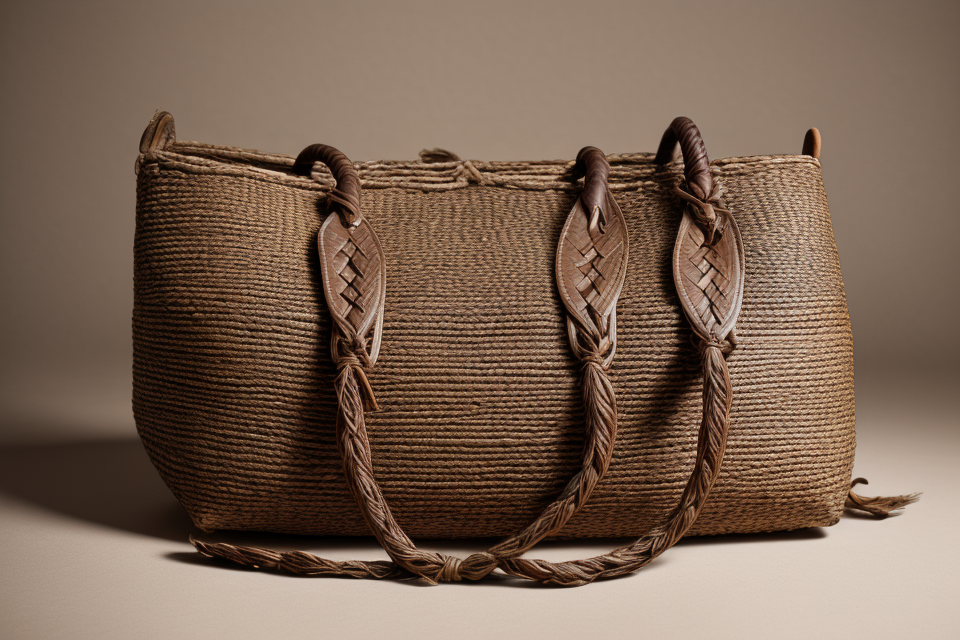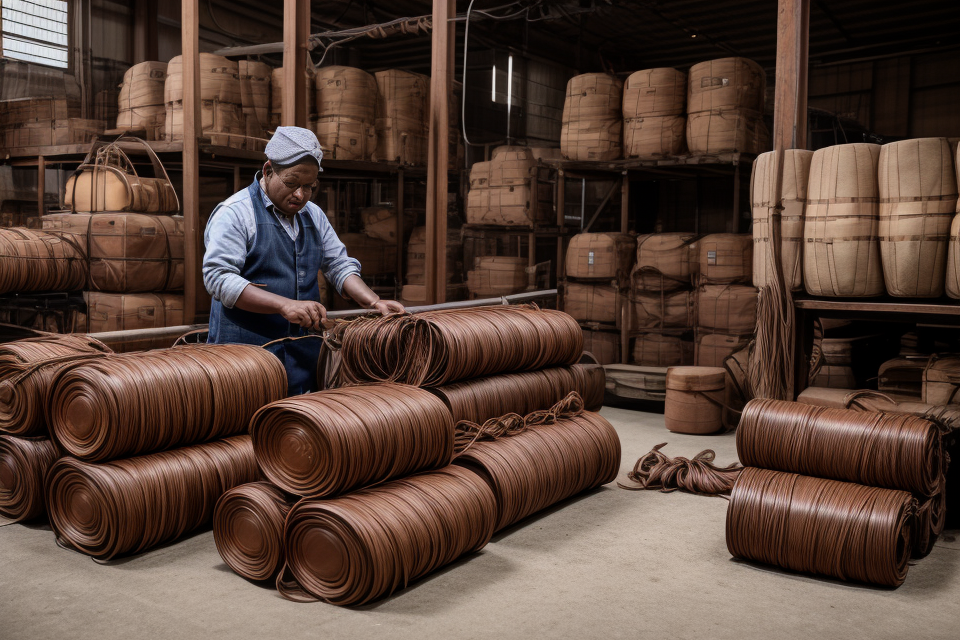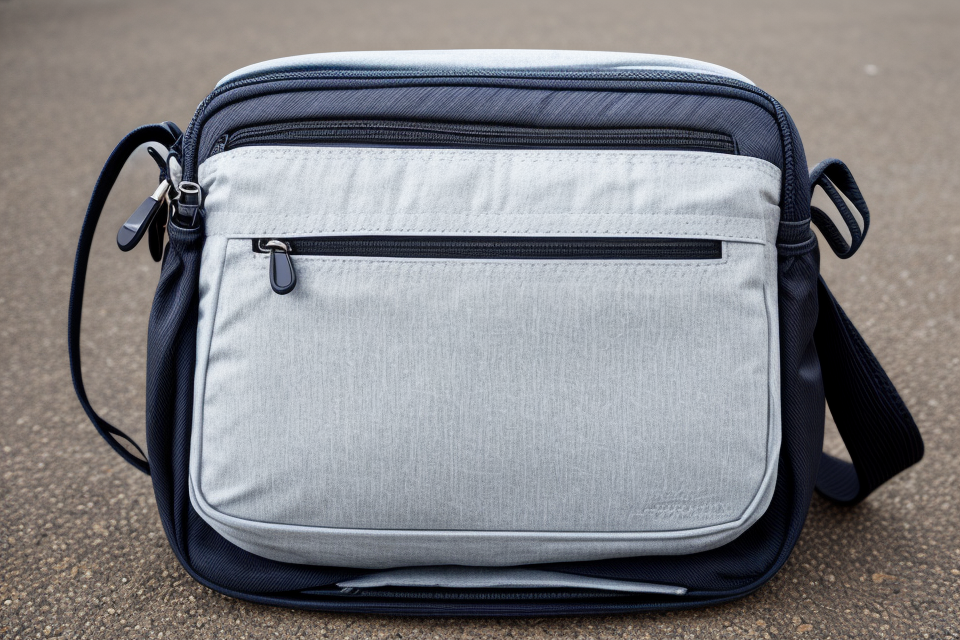Have you ever wondered what materials were used to make bags a long time ago? It’s fascinating to think about the evolution of this everyday item. From ancient civilizations to medieval times, the materials used to make bags have varied greatly. From woven fabrics to animal hides, let’s take a journey through time to explore the different materials used to make bags throughout history. Get ready to be amazed by the ingenuity and creativity of our ancestors!
Bags have been made from a variety of materials throughout history, including leather, cloth, woven fibers, and even animal hide. In ancient civilizations, bags were often made from natural materials that were readily available, such as woven reeds or straw. As time went on, materials like linen and cotton became more commonly used for making bags, as they were more durable and versatile. Leather was also a popular choice for making bags, as it was strong and long-lasting. Bags made from these materials were often used for carrying everyday items, such as food, tools, and personal belongings. As technology has advanced, modern materials like nylon and polyester have become popular for making bags, as they are lightweight, waterproof, and easy to clean.
The Evolution of Bag Making Materials
Natural Fibers
Natural fibers have been used for centuries to make bags and other textiles. These fibers are derived from plants or animals and can be woven or knitted into a variety of fabrics.
Hemp
Hemp is one of the oldest and most durable natural fibers used in bag making. It is extracted from the stem of the Cannabis sativa plant and is known for its strength and flexibility. Hemp fibers are very strong and can be woven into a variety of textures, making it an ideal material for making bags that can withstand a lot of wear and tear.
Linen
Linen is another popular natural fiber used in bag making. It is made from the flax plant and is known for its softness and durability. Linen fibers are strong and absorbent, making it an ideal material for making bags that can protect items from moisture. Linen is also a popular choice for summer bags as it is lightweight and breathable.
Silk
Silk is a luxurious natural fiber that has been used for centuries to make bags and other textiles. It is made from the cocoons of silkworms and is known for its softness and shine. Silk fibers are very fine and smooth, making it an ideal material for making bags that are soft to the touch. Silk is also a popular choice for evening bags and other formal occasions.
Wool
Wool is a natural fiber that is derived from sheep and other animals. It is known for its warmth and insulation properties, making it an ideal material for making bags that can keep items warm in cold weather. Wool fibers are also very soft and flexible, making it an ideal material for making bags that can be molded into different shapes and sizes.
Animal Products
In the past, animal products were commonly used to make bags. These materials were often chosen for their durability, strength, and unique textures.
Leather
Leather was one of the most popular materials used to make bags. It was obtained from the hides of various animals, such as cows, sheep, and goats. The process of tanning leather involved treating the hide with various chemicals to make it more durable and less prone to decay. Leather bags were often soft and flexible, yet strong enough to withstand the wear and tear of daily use. They were also water-resistant, making them ideal for carrying wet or dirty items.
Fur
Fur was another material that was used to make bags in the past. The fur of animals such as foxes, rabbits, and bears was highly prized for its softness and warmth. Fur bags were often lined with fabric or other materials to make them more comfortable to touch and to protect the fur from damage. These bags were popular among wealthy individuals who could afford the high cost of the material.
Horn and Bone
Horn and bone were also used to make bags in the past. Horn was a popular material because it was strong and durable, yet lightweight. It was often used to make small bags or pouches that could be attached to a belt or worn around the neck. Bone was also used to make bags, particularly in the form of bone handles or decorative elements. These bags were often highly decorative and were used for special occasions.
Recycled Materials
Recycled materials have been used to make bags for a long time. In fact, the concept of recycling has been around for centuries, and people have been repurposing old clothes, fabrics, and animal hides to make bags for a variety of purposes.
Old Clothes
One of the most common materials used to make bags in the past was old clothes. People would take worn-out garments that were no longer suitable for wear and cut them up to make bags. These bags were often used for everyday purposes such as carrying groceries or books. The clothes used to make the bags could be made of any material, including cotton, wool, silk, and linen.
Old Fabrics
Another material that was commonly used to make bags was old fabrics. These could be pieces of cloth that were no longer needed or that had become too worn to use for their intended purpose. The fabrics could be made of a variety of materials, including cotton, silk, and wool. They were often cut into specific shapes and sizes to make bags that were suitable for different purposes.
Animal Hides
Animal hides were also used to make bags in the past. These could be the hides of animals such as cows, sheep, and goats. The hides were tanned and treated to make them soft and pliable, and then they were cut and sewn into bags. These bags were often used for carrying items such as tools, food, and other supplies.
Overall, recycled materials have been an important part of the history of bag making. By repurposing old clothes, fabrics, and animal hides, people were able to create bags that were both practical and sustainable.
Synthetic Materials
In recent times, synthetic materials have become increasingly popular in the production of bags. These materials are derived from chemical compounds and are known for their durability, strength, and resistance to wear and tear.
Plastic
Plastic is one of the most commonly used synthetic materials in the production of bags. It is versatile and can be molded into various shapes and forms. Low-density polyethylene (LDPE) and high-density polyethylene (HDPE) are two types of plastic that are commonly used in the production of bags. LDPE is used to make lightweight bags, while HDPE is used to make thicker and more durable bags.
Nylon
Nylon is another popular synthetic material used in the production of bags. It is strong, lightweight, and has a high resistance to abrasion. Nylon is also resistant to moisture, making it an ideal material for outdoor activities. It is commonly used to make backpacks, sports bags, and travel bags.
Polyester
Polyester is a synthetic fiber that is made from polyethylene terephthalate (PET) polymers. It is strong, lightweight, and resistant to water, oil, and chemicals. Polyester is commonly used to make clothing, upholstery, and carpeting, as well as bags. It is a popular choice for backpacks, handbags, and luggage due to its durability and resistance to wear and tear.
Overall, synthetic materials have revolutionized the bag-making industry by providing an alternative to traditional materials such as leather and canvas. These materials are lightweight, durable, and versatile, making them ideal for a wide range of applications.
Innovative Materials
Biodegradable Plastics
Biodegradable plastics have emerged as a sustainable alternative to traditional plastics. These materials break down into natural elements when exposed to air, water, or sunlight, reducing the amount of plastic waste in the environment. They are made from renewable resources like corn, potato, or sugarcane starch, which are processed to create biodegradable polymers.
Plant-Based Polyester
Plant-based polyester is another eco-friendly material used in bag making. It is made from polymers derived from plant materials, such as corn, soybeans, or recycled cotton. This material is known for its durability and versatility, as it can be molded into various shapes and designs. Compared to traditional polyester, plant-based polyester production emits fewer greenhouse gases and requires less energy.
Carbon-Neutral Textiles
Carbon-neutral textiles are manufactured using processes that emit no or minimal greenhouse gases. This involves the use of renewable energy sources, energy-efficient technologies, and innovative production methods. For instance, some manufacturers use carbon offsetting strategies, where they invest in projects that reduce greenhouse gas emissions elsewhere to compensate for their own emissions. Other methods include employing closed-loop systems, where waste materials are recycled and repurposed to minimize environmental impact.
While these innovative materials offer a more sustainable approach to bag making, it is essential to consider their scalability, cost-effectiveness, and overall impact on the environment. As technology continues to advance, researchers and manufacturers are exploring new materials and production techniques to create environmentally friendly bags that are both functional and durable.
The Significance of Material Choice in Bag Making
Environmental Impact
When it comes to the environmental impact of bag making materials, there are several factors to consider. The choice of materials can have a significant impact on the environment, both in terms of the immediate and long-term effects.
Landfill Waste
One of the most pressing environmental concerns associated with bag making materials is the amount of waste that ends up in landfills. Many traditional materials used to make bags, such as plastic and non-biodegradable synthetic fibers, take hundreds of years to decompose, leading to long-term environmental damage. In contrast, biodegradable materials such as jute, cotton, and hemp break down much more quickly, reducing the amount of waste in landfills.
Greenhouse Gas Emissions
Another important environmental concern is the greenhouse gas emissions associated with the production and disposal of bag making materials. For example, the production of synthetic fibers like polyester and nylon requires large amounts of energy and results in significant carbon emissions. Additionally, the transportation of raw materials and finished products contributes to carbon emissions, further exacerbating the problem.
Resource Depletion
Finally, the depletion of natural resources is another environmental concern associated with bag making materials. The production of synthetic fibers like polyester and nylon requires large amounts of oil and gas, which are non-renewable resources. In contrast, biodegradable materials like jute, cotton, and hemp are renewable resources that can be replenished over time.
Overall, the environmental impact of bag making materials is significant, and it is important to choose materials that are sustainable and environmentally friendly.
Cultural Significance
Craftsmanship
The choice of materials for making bags a long time ago was often influenced by the cultural significance of craftsmanship. Many communities placed great value on the skill and expertise involved in creating handmade bags, which were seen as a reflection of the artisan’s talent and creativity. As a result, the materials used in bag making were carefully selected to showcase the craftsperson’s abilities and to create bags that were not only functional but also aesthetically pleasing.
Symbolism
The materials used to make bags a long time ago were also often imbued with symbolic meaning. For example, in some cultures, certain materials were believed to have spiritual or mystical properties, and were therefore used in the creation of bags that were intended to impart protection or good fortune to the owner. Additionally, the colors and patterns used in the materials could also carry symbolic significance, such as representing different seasons or life stages.
Storytelling
In many cultures, bags were not just functional objects, but also served as vehicles for storytelling and cultural expression. The materials used in their creation could help to convey the stories and traditions of a community, and could be used to depict scenes from myths and legends, or to represent important historical events. As a result, the choice of materials for making bags was often carefully considered in order to create bags that were not only practical, but also meaningful and expressive.
The Future of Bag Making Materials
Sustainable Practices
As society becomes more conscious of the impact of human activities on the environment, sustainable practices have become increasingly important in various industries, including the manufacturing of bags. In this section, we will discuss some of the sustainable practices that are being adopted in the production of bags.
Upcycling
Upcycling is the process of converting waste materials into new products of higher quality or value than the original material. In the context of bag making, upcycling involves using discarded or leftover materials to create new bags. This practice not only reduces waste but also conserves resources and energy. For example, some bag makers are using upcycled plastic bottles to create durable and stylish backpacks.
Recycling
Recycling is the process of converting waste materials into new products that are identical or similar to the original materials. In the context of bag making, recycling involves using recycled materials to create new bags. This practice helps to reduce the consumption of new raw materials and energy, as well as the amount of waste sent to landfills. For example, some bag makers are using recycled polyester to create waterproof and durable bags.
Composting
Composting is the process of breaking down organic materials into a soil-like substance that can be used to fertilize plants. In the context of bag making, composting involves using organic materials such as cotton and linen to create biodegradable bags. This practice helps to reduce the amount of non-biodegradable waste in the environment and promote sustainable waste management.
Eco-Friendly Materials
Eco-friendly materials are materials that are derived from renewable resources or that can be reused or recycled without causing harm to the environment. In the context of bag making, eco-friendly materials include bamboo, jute, and cork. These materials are durable, biodegradable, and sustainable, and they can be used to create a wide range of bags, from shopping bags to backpacks.
In conclusion, sustainable practices are becoming increasingly important in the manufacturing of bags. Upcycling, recycling, composting, and the use of eco-friendly materials are some of the sustainable practices that are being adopted by bag makers to reduce waste, conserve resources, and promote sustainable waste management.
Technological Advancements
Biomimicry
Biomimicry is the process of creating materials that mimic natural materials. In the context of bag making, this could involve using materials like spider silk or cactus fibers to create strong, durable bags.
3D Printing
3D printing technology has advanced significantly in recent years, and it has the potential to revolutionize the way bags are made. With 3D printing, it is possible to create complex shapes and designs that would be difficult or impossible to create using traditional manufacturing methods. Additionally, 3D printing allows for greater customization and personalization of bags.
Nanotechnology
Nanotechnology involves manipulating materials at the molecular or atomic level. In the context of bag making, this could involve using nanomaterials to create stronger, more durable bags. For example, researchers are currently exploring the use of nanoscale clay particles to reinforce synthetic materials like polyester.
Smart Textiles
Smart textiles are fabrics that have been designed to interact with their environment in some way. In the context of bag making, this could involve using materials that change color or texture in response to temperature or humidity changes. Additionally, smart textiles could be used to create bags that are self-cleaning or antimicrobial.
FAQs
1. What materials were used to make bags a long time ago?
A long time ago, bags were made from a variety of materials depending on the region and the purpose of the bag. Some of the most common materials used to make bags include leather, woven fabric, animal hide, wicker, and reeds. Leather was a popular choice for making bags because it was durable and could be easily shaped and molded. Woven fabric, such as cotton or linen, was also commonly used to make bags because it was lightweight and flexible. Animal hide, wicker, and reeds were also used to make bags, especially for carrying heavy loads or for use in outdoor activities.
2. How were bags made a long time ago?
The process of making bags a long time ago was often labor-intensive and required a lot of skill and craftsmanship. For example, leather bags were made by tanning the hide, cutting it into the desired shape, and then sewing it together using needles and thread. Woven fabric bags were made by weaving together strands of cotton, linen, or other fibers on a loom. Animal hide, wicker, and reed bags were often made by weaving or sewing the material together to create a strong and durable bag. The exact process of making bags depended on the materials used and the intended purpose of the bag.
3. What were bags used for a long time ago?
Bags were used for a variety of purposes a long time ago, including carrying personal belongings, food, and other items. Bags made from leather or woven fabric were often used as everyday bags for carrying small items such as coins, keys, and sewing supplies. Animal hide, wicker, and reed bags were often used for carrying heavier loads, such as tools, food, or water. Bags were also used for ceremonial purposes, such as carrying offerings to temples or for religious festivals. In addition, bags were often used as part of traditional costumes or as decorative accessories.



